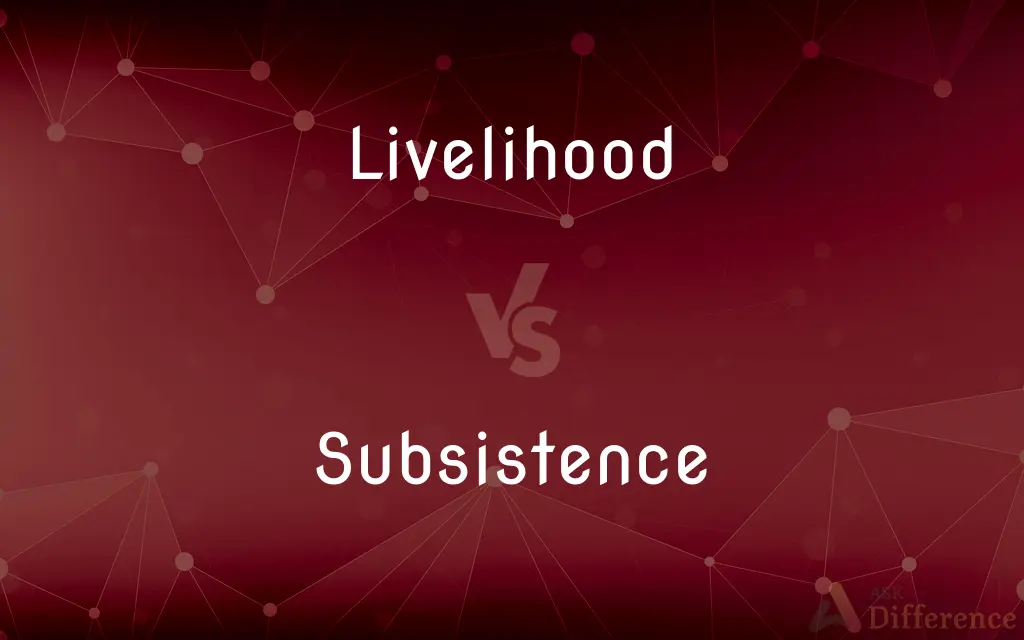Livelihood vs. Subsistence — What's the Difference?
By Maham Liaqat & Fiza Rafique — Updated on May 8, 2024
Livelihood involves means of securing the necessities of life, focusing on economic and social activities; subsistence refers specifically to the minimum resources necessary for survival.

Difference Between Livelihood and Subsistence
Table of Contents
ADVERTISEMENT
Key Differences
Livelihood encompasses the various means and activities through which people earn their living and sustain themselves economically and socially, while subsistence primarily focuses on obtaining the bare minimum resources required for physical survival.
Livelihood can include jobs, businesses, and other economic activities that provide a standard of living beyond mere survival, whereas subsistence often refers to situations where individuals or communities are just meeting their basic needs such as food and shelter.
Livelihood is often discussed in terms of improving quality of life and economic development, highlighting its broader scope and potential for growth, while subsistence is associated with a static state of just maintaining life, emphasizing limitation and basic survival.
Livelihood strategies may vary widely from urban to rural settings, involving diverse economic opportunities and social networks, whereas subsistence strategies are typically constrained by the availability of natural resources and are often rural or traditional.
Livelihood studies might focus on income diversification, job creation, and sustainable development, emphasizing dynamic socio-economic environments, whereas subsistence studies might focus on issues like food security and resource access, stressing survival strategies.
ADVERTISEMENT
Comparison Chart
Definition
Means of making a living with economic activities
Minimum essentials needed to support life
Focus
Economic growth, social enhancement
Basic survival, meeting essential needs
Scope
Broad, can include various economic sectors
Narrow, focused on basic resources like food, shelter
Context of use
Development studies, sociology, economics
Ecology, anthropology, emergency aid
Potential for change
Dynamic, can evolve and expand
Static, aimed at maintaining basic living conditions
Compare with Definitions
Livelihood
Economic activities engaged in to earn a living.
She supports her livelihood through freelance writing.
Subsistence
The action or fact of maintaining or supporting oneself at a minimal level.
The remote village lives in subsistence farming.
Livelihood
Opportunities to improve one’s standard of living.
Education is often seen as a pathway to a better livelihood.
Subsistence
Survival with minimal means.
Subsistence fishing is a way of life in coastal communities.
Livelihood
The state of having a stable source of financial income.
The new factory offered livelihoods to hundreds of the town's residents.
Subsistence
Living off the land using the resources available.
Many indigenous tribes use subsistence hunting and gathering.
Livelihood
The means by which an individual secures the basic necessities of life.
He turned his passion for woodworking into a livelihood.
Subsistence
The state of having just enough resources to live.
After the disaster, they were reduced to subsistence level.
Livelihood
The way in which a person can make a stable living.
Farming is the primary livelihood for many in rural areas.
Subsistence
The minimum resources necessary for long-term physical well-being.
In harsh climates, subsistence requires careful management of resources.
Livelihood
A person's livelihood (derived from life-lode, "way of life"; cf. OG lib-leit) refers to their "means of securing the basic necessities (food, water, shelter and clothing) of life".
Subsistence
The act or state of subsisting.
Livelihood
Means of support; subsistence.
Subsistence
A means of subsisting, especially means barely sufficient to maintain life.
Livelihood
A means of providing the necessities of life for oneself (for example, a job or income).
An independent livelihood;
To make / earn / gain a good livelihood
Subsistence
Something that has real or substantial existence.
Livelihood
Property which brings in an income; an estate.
Subsistence
(Christianity) Hypostasis.
Livelihood
(obsolete) Liveliness; appearance of life.
Subsistence
Real being; existence.
Livelihood
(obsolete) The course of someone's life; a person's lifetime, or their manner of living; conduct, behaviour.
Subsistence
The act of maintaining oneself at a minimum level.
Livelihood
Subsistence or living, as dependent on some means of support; the means for support of life; maintenance.
The opportunities of gaining an honest livelihood.
It is their profession and livelihood to get their living by practices for which they deserve to forfeit their lives.
Subsistence
Inherency.
The subsistence of qualities in bodies
Livelihood
Liveliness; appearance of life.
Subsistence
Something (food, water, money, etc.) that is required to stay alive.
Livelihood
The financial means whereby one lives;
Each child was expected to pay for their keep
He applied to the state for support
He could no longer earn his own livelihood
Subsistence
(theology) Embodiment or personification or hypostasis of an underlying principle or quality.
Subsistence
Real being; existence.
Not only the things had subsistence, but the very images were of some creatures existing.
Subsistence
Inherency; as, the subsistence of qualities in bodies.
Subsistence
That which furnishes support to animal life; means of support; provisions, or that which produces provisions; livelihood; as, a meager subsistence.
His viceroy could only propose to himself a comfortable subsistence out of the plunder of his province.
Subsistence
Same as Hypostasis, 2.
Subsistence
Minimal (or marginal) resources for subsisting;
Social security provided only a bare subsistence
Subsistence
A means of surviving;
Farming is a hard means of subsistence
Subsistence
The state of existing in reality; having substance
Common Curiosities
What are common methods of subsistence in remote areas?
Common methods include hunting, gathering, subsistence farming, and utilizing local natural resources.
Why is understanding livelihood important in social sciences?
Understanding livelihood is crucial for addressing issues of poverty, economic development, and sustainable living standards.
How do economic policies impact livelihoods differently than subsistence?
Economic policies can dramatically shape livelihoods by affecting job opportunities and economic growth, while their impact on subsistence may be more related to access to basic necessities like food and shelter.
What environmental factors are critical for subsistence?
Environmental factors crucial for subsistence include climate, soil fertility, water availability, and access to natural resources, all of which determine the feasibility of farming, fishing, and gathering.
What is the main difference between livelihood and subsistence?
Livelihood refers to the means and activities through which people secure the necessities of life, potentially including economic growth, whereas subsistence refers to maintaining life at the most basic level of needs.
Can subsistence be considered a type of livelihood?
Yes, subsistence can be considered a form of livelihood, specifically one that focuses on minimal survival without economic excess.
How do livelihood activities differ from subsistence activities?
Livelihood activities may include a variety of economic engagements that provide a comfortable living, whereas subsistence activities strictly ensure survival with no excess.
What role does culture play in defining livelihoods and subsistence?
Culture significantly influences what constitutes livelihoods and subsistence, affecting the methods and resources used by different communities to sustain themselves.
How does urbanization affect livelihoods and subsistence?
Urbanization can expand livelihood opportunities through increased job diversity and economic activities, but it can challenge traditional subsistence practices by reducing access to natural resources.
What is the link between education and livelihood?
Education directly enhances livelihood prospects by equipping individuals with skills and knowledge that increase employability and potential for economic improvement.
What are the health implications of subsistence living?
Subsistence living can lead to health challenges due to limited access to nutritious food, healthcare, and sanitation, impacting overall well-being.
In what ways do technological advancements influence livelihoods?
Technological advancements can enhance livelihoods by creating new jobs, increasing productivity, and opening up markets, whereas their impact on subsistence may center on improving efficiency in resource use.
Can changes in climate affect subsistence more than livelihoods?
Climate change can have a profound impact on subsistence by altering the availability of essential natural resources, whereas its impact on livelihoods might be more variable, depending on the economic sectors involved.
How do communities transition from subsistence to sustainable livelihoods?
Communities transition by integrating more diverse economic activities, improving education, accessing better technology, and receiving support through policies and investments aimed at sustainable development.
How do conflict and stability affect subsistence and livelihood?
Conflict can disrupt both subsistence and livelihood by causing displacement and resource scarcity, whereas stability tends to support the sustainability of both.
Share Your Discovery

Previous Comparison
Degree vs. Title
Next Comparison
Avoirdupois vs. TroyAuthor Spotlight
Written by
Maham LiaqatCo-written by
Fiza RafiqueFiza Rafique is a skilled content writer at AskDifference.com, where she meticulously refines and enhances written pieces. Drawing from her vast editorial expertise, Fiza ensures clarity, accuracy, and precision in every article. Passionate about language, she continually seeks to elevate the quality of content for readers worldwide.












































